Introducing artificial depth cues to improve task performance in ITER maintenance actions
Abstract:
Maintenance operations on ITER tokamak components will be largely performed by remote handling. In previous work it was shown that representative maintenance tasks could be performed significantly faster with direct visual feedback than with camera feedback. In post-test interviews, operators indicated that they regarded the lack of 3D perception as the primary factor hindering their performance.
This paper discusses various techniques to improve depth perception in teleoperation, including stereo vision, head tracking, virtual camera views and depth gauges. The most promising techniques were tested. Performance metrics included time-to-complete, path analysis and operator work-load.
In a first experiment, artificial depth gauges views were tested in a 1:1 scale hardware testbed with mechanical master-slave manipulators handled by experienced operators. Robust real-time image processing was achieved with marker-based objects. The simple depth gauge and graphical overlay did not significantly improve task performance. Operators commented on their view of the task being “obstructed” by the graphical overlay, and the depth gauge was judged not very informative.
In a second experiment, real time tracking was combined with VR display including stereo and head tracking. While stereo was found to improve the task performance significantly over the 1 camera (mono) condition, head tracking unexpectedly did not.
